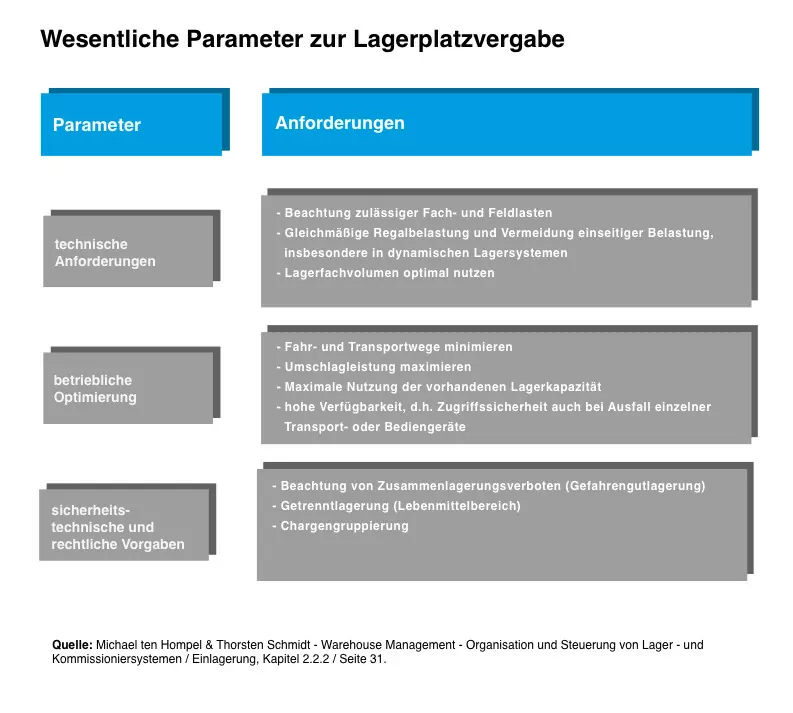The storage location management ensures that a storage location is recorded or occupied in width, height and depth. It covers two different topological aspects. On the one hand the overall structure of the warehouse and thus the positions of the individual storage locations, on the other hand, the actual bin management within a single storage location. They are stored there either in rough spatial divisions or to the exact square millimetre. In addition, storage based on filling quantities (loose parts) is not uncommon.
The storage location management is part of a warehouse management system and, together with the material flow control, forms the heart of a warehouse or distribution center. The software coordinates the storage and retrieval as well as the transfer to or from the smallest spatial unit (storage location) of a warehouse. For this regulation, the system uses a previously stored set of rules, which, for example, contains the properties of a pallet(width, length, height, pallet type), the stock to be put away (length, width, height, weight, handling of the material to be put away or taken away) and the respective storage location (statics, area, height, depth, storage strategy) and sets them in relation to each other.
Example: Especially in the case of non-uniform storage compartment capacities, a weight check or contour check is absolutely necessary before storage. Both checks can take place, for example, at an identification point – if such a check is technically provided for there.

Storage location management: warehouse infrastructure, warehouse processes and the information flow
In addition to the constant exchange of information between the ERP system and the respective warehouse processes, warehouse components and individual warehouse sections are linked with each other by information technology (see zones). The warehouse infrastructure, as well as the warehouse processes and the associated information flow, are therefore elementary components of a location management system.
Note: The storage location management is thus able to define the storage capacity as well as the storage performance down to the last storage location exactly with the information from the inventory management and order management.
Storage location management requires the following elements for this
- Turnover rate, medium inventory
- Fixed location principle, free location principle (chaotic location management)
- Seasonal influences on special load peaks
- Storage strategy: stock, buffer, picking
- Storage location dimension (number of articles, article dimension)
A storage infrastructure includes
- Warehouse layout (shelves, lane systems) and the storage equipment
- Conveyor layout, conveyor systems
The storage processes include
- Storage, removal and transfer processes
- Information and control processes
- Information and communication technology (ICT)
Location management and zones
For example, in order to bring together the physically separate high-bay storage (HBS) with the picking stations in front of it, virtual zones are laid over individual sections of the warehouse. In this way, the warehouse is not only divided, but each section can be assigned different individual customer parameters (putaway and picking strategy). HBS, conveyor landscape, picking stations are from now on organizationally linked with each other.
Note: It is also possible to create higher-level zones that use information from the lower-level zones in order to achieve an even workload, for example at the individual picking stations. The individual zones are split according to customer-specific or country-specific parameters, turnover frequency and stock dimensions (only if required).
Placement of items
Due to varying demand and characteristics, certain articles must be handled individually during storage and retrieval, replenishment and picking. In the manual picking warehouse, for example, fast-moving products are placed at quickly accessible shelf heights, while slow-moving products tend to be placed in upper shelf areas. Heavy articles can be placed on the bottom of the shelves, for example. Both zones and different storage location indexing strategies within the respective zone help to achieve optimum storage location management – each storage location can still be individually parameterized in the individual zones.

However, the individual division of a warehouse into zones can also have other reasons:
- Properties of the stock (cooling required, highly flammable, neighbourhood conflict – articles must not be stored together)
- Different temperature zones
- Different storage strategies in different storage sections
- Securing high quality stock
Summary
The importance of storage location management is already apparent during warehouse planning. The warehouse infrastructure and warehouse processes play a decisive role there. All master data on the stock, the conveyor landscape and the storage strategy itself are individually evaluated and statistically recorded for each stock movement. The storage location management can thus assign the respective storage location in width, height and depth and, according to the order, place goods into and out of storage there.
For more information about warehouse management, see also ‘Profitable Warehouse Management via Specialist Management‘ and ‘Process-oriented Warehouse Planning‘.
Teaser- and storage images: Dr. Thomas + Partner
Also available in Deutsch (German)